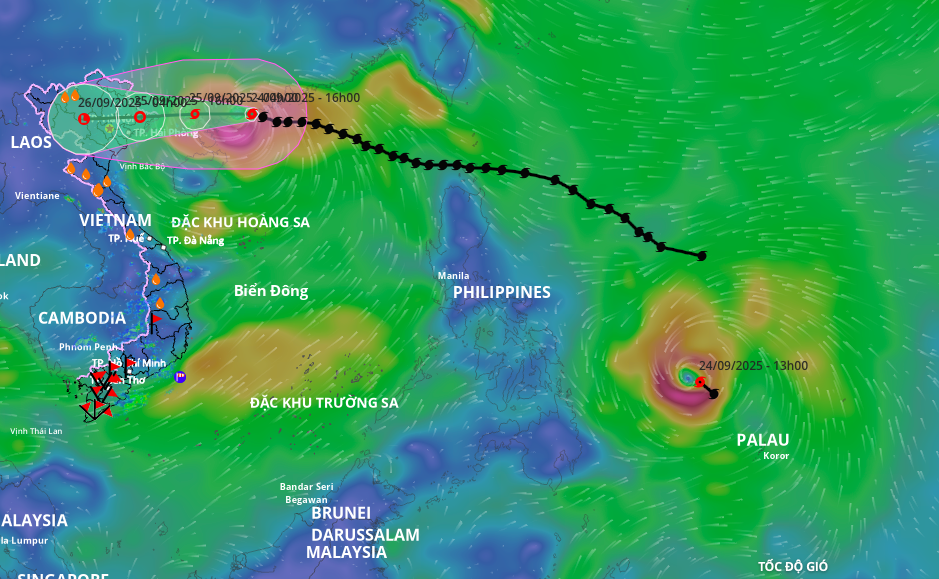Since the beginning of the year, the South China Sea has recorded 9 typhoons and 4 tropical depressions, with Typhoon Bualoi expected soon. The National Center for Hydrometeorological Forecasting stated that the number of typhoons and tropical depressions in the first 9 months is 5 more than the multi-year average.
In the past 5 years (2021-2024), the number of typhoons by the end of September typically ranged from 4 to 6, with a maximum of 6. In September 2025 alone, the South China Sea experienced 4 typhoons (Ragasa, Mitag, Tapah, and the upcoming Bualoi) and one tropical depression, two more than the multi-year average for the month.
 |
Mai Van Khiem, Director of the National Center for Hydrometeorological Forecasting. Photo: Gia Chinh |
Mai Van Khiem, Director of the National Center for Hydrometeorological Forecasting, explained that the direct cause of the high number of typhoons in September is the activity of the intertropical convergence zone. This zone is currently very active and stable near the equator – a region highly conducive to the formation of atmospheric disturbances and small vortices.
"These disturbances are the seeds that develop into tropical depressions and then into typhoons," Khiem said. Most recently, Typhoons Ragasa and Bualoi formed through this mechanism.
According to Khiem, the two key factors in typhoon formation are heat and dynamic forces. Regarding heat, a sea surface temperature of 26-27 degrees Celsius is sufficient to initiate a typhoon. Currently, the sea surface temperature in the Northwest Pacific Ocean and east of the Philippines is 28-29 degrees Celsius.
The dynamic conditions are also currently very favorable for typhoon formation. September marks the transition from summer to autumn, a time when the southwest monsoon is strong, combining with easterly wind disturbances from the subtropical high-pressure system. This interaction creates medium-scale cyclones, helping small disturbances at sea rapidly develop into low-pressure areas and typhoons.
Dr. Truong Ba Kien, Deputy Director of the Center for Meteorological and Climate Research at the Institute of Hydrometeorology and Climate Change, said that due to the current neutral state of ENSO (changes in sea surface temperature in the equatorial Pacific Ocean), with the possibility of La Nina appearing later this year, the number of typhoons in the South China Sea is expected to be approximately at or above the multi-year average. The multi-year average is 12-13 typhoons, of which 6-7 directly affect Vietnam.
In addition to the ENSO state, Dr. Kien said that a crucial factor is global climate change. Recent studies indicate that rising sea surface temperatures, along with higher atmospheric moisture content, are fueling typhoons, leading to a marked increase in the proportion of strong typhoons and super typhoons in recent decades. This trend is expected to continue under the influence of global warming.
Central Vietnam enters peak typhoon and rainy season.
Dr. Truong Ba Kien predicts that in the last three months of the year, the number of tropical cyclones in the South China Sea is forecast to be approximately the multi-year average, meaning 4-5 typhoons, of which 2-3 will directly affect Vietnam, concentrated mainly in the central region.
The greatest risks for the remainder of the typhoon season include: heavy rain, flash floods, landslides in the central region and Central Highlands; rising water levels, large waves, and high tides along the coast when strong typhoons make landfall or have a direct impact; and continuous typhoon-related rain, causing a risk of "compounded flooding," threatening the safety of dikes and reservoirs.
 |
Two typhoons appear simultaneously in the Northwest Pacific Ocean. Image: Disaster monitoring system |
Mai Van Khiem also stated that September is just the beginning of the central region's rainy and typhoon season. Typically, the peak typhoon season in this area is from September to November, and can even extend into early December.
"With unusually high sea surface temperatures, the risk of strong typhoons occurring in October and November is entirely possible. Historical statistics show that many very strong typhoons have formed east of the Philippines and then entered central Vietnam during this period," Khiem said.
Both experts warn that, given that at least three typhoons have caused rain and flooding in the central region since the beginning of the year, residents and local authorities need to closely monitor forecast bulletins updated every 6-12 hours; reinforce houses, anchor boats, trim trees, and check reservoirs before typhoons arrive.
At the same time, authorities need to prepare evacuation plans, food, clean water, and backup power sources, ready for unpredictable and consecutive typhoons. Transportation, agriculture, and electricity sectors should proactively develop response plans, harvest crops and aquatic products early in at-risk areas, lower reservoir water levels, and deploy forces to handle infrastructure incidents.
Gia Chinh












